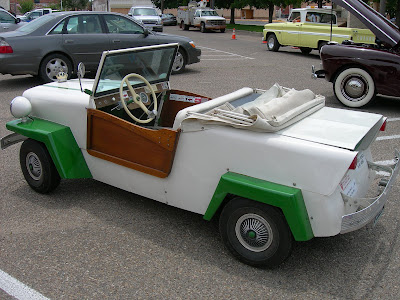There was a car show at a downtown bank's parking lot and I noticed this little gem straightaway.

From a car club website:
The evolution of King Midget began in 1946 when Claud Dry and Dale Orcutt, who met while civil air patrol pilots during World War II, conceived King Midget as an inexpensive, affordable car that anyone could buy. They developed and sold King Midget as a single passenger kit car in which any single cylinder engine could be installed. The kit contained the frame, axles, springs, steering mechanism, dimensioned patterns for the sheet metal, which could be fabricated by a local metalsmith, and an assembly book. In the late 1940’s, and through 1951, the Model 1 became available from the factory as either a kit or as a fully assembled car with a 6 h.p. Wisconsin engine.
Glancing through the different types, I determined that this was a Model 2.
(NOTE: I've been informed in the comments section that it is a Model 3. Thanks to the two posters who set me straight...and their courtesy is much appreciated. I've been corrected several times before on other posts but in a rude manner...and a couple of times they were the wrong ones, not me. In this case I'll defer to the experts. - Mike)
Note the crown hood ornament.


By 1951, Dry and Orcutt had developed the second model King Midget, a two passenger convertible offered either fully assembled or as a kit, powered by the 7.5 horsepower Wisconsin AENL engine. This model firmly established King Midget's reputation and incredible ability to perform extraordinary feats. It could carry more than its own weight, it could pull exceptionally heavy loads, it had the agility of a mountain goat; all over arduous terrain with durability and economy for thousands of miles.
It began as the 500 pound car for $500. The Model 2 King Midget was a basic vehicle with a hand start cable on the left, outside behind the seat. It had a black three spoke steering wheel, brown plastic seat upholstery, no speedometer and no reverse.
However, it was this model which first offered the optional automatic transmission, reverse, electric starter, shatter proof safety-glass tinted windshield, top, steel winter doors with sliding Plexiglas windows, hot air heater, speedometer, turn signals, hand operated controls for handicapped persons and the golf model, complete with two golf bag racks, extra wide traction tires on the rear, special low gearing, foot rests on the front fenders and an extra quiet muffler system. The Custom model was introduced in 1955, along with the standard model King Midget. The Custom got a new two spoke white steering wheel, bright red and bone white upholstery, chrome bumper and cowl parking lights. New Philippine mahogany doors and winter enclosures became standard for both models, too.


Welcome to ToTG!
|
May 22, 2009
King Midget
Subscribe to:
Post Comments (Atom)



3 comments:
Just read your article on the King Midget and enjoyed it very much. You stated in your article that you believe this vehicle pictured to be a Model 2, well it really is a Model 3. I own two King Midgets and one is a 1958 KM M3 and the other is a 1967 KM M3. Great article though!
You are correct. This is a 1958 KM M3 that was restored in 1995 by my father John McCarter of Mansfield, Ohio. It has won numerous awards at different car shows, and has even made a lap around Bristol Motor Speedway! It made the long journey from Columbus,Ohio to Texas in early 2009. Great article and glad to see that she is still being appreciated!
Sorry to have been so long in replying; just noticed a hit on this post and thought I should reply.
I appreciate the clarification - I was going by the photos at the link and made a guess. Thanks to you both for the correction and information and compliments and I'd really like to thank you for your polite and gentle way of setting me straight. It's a rare thing these days on the 'net, huh?
Again, thanks.
Post a Comment